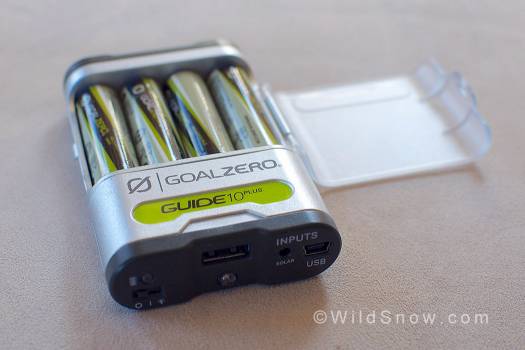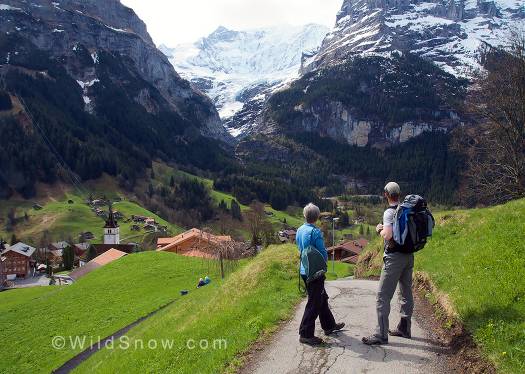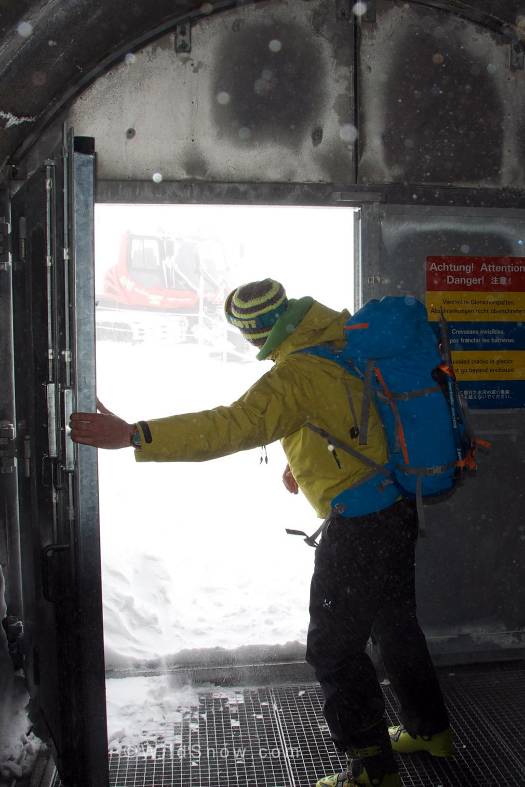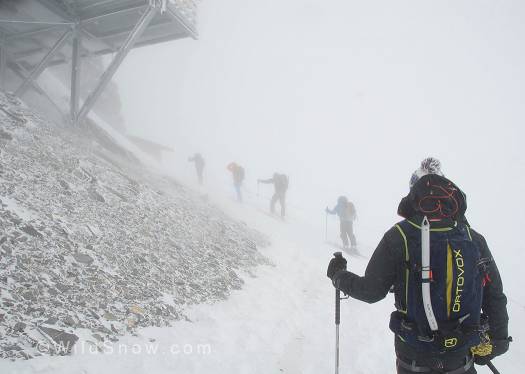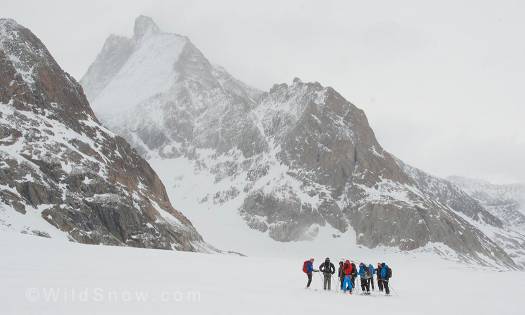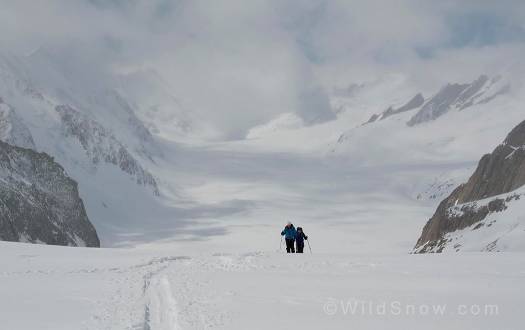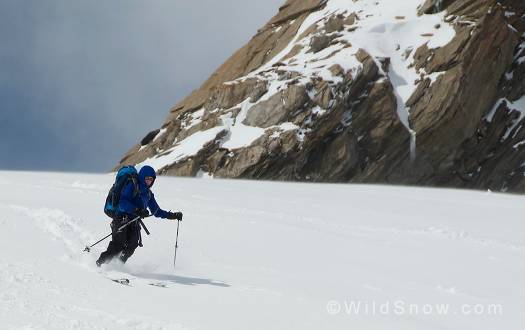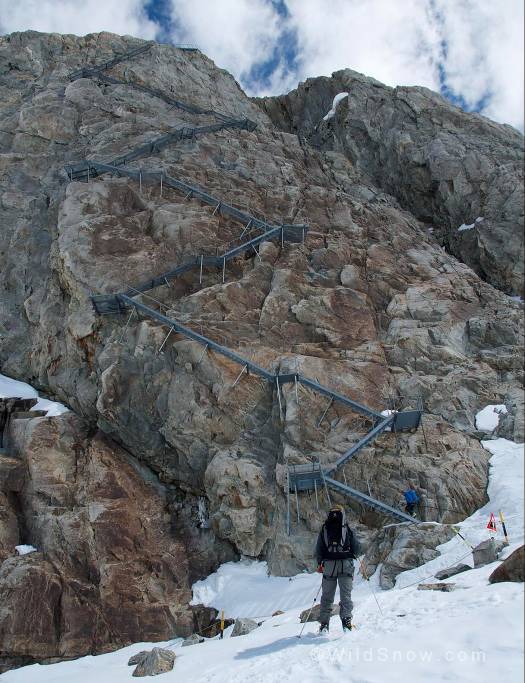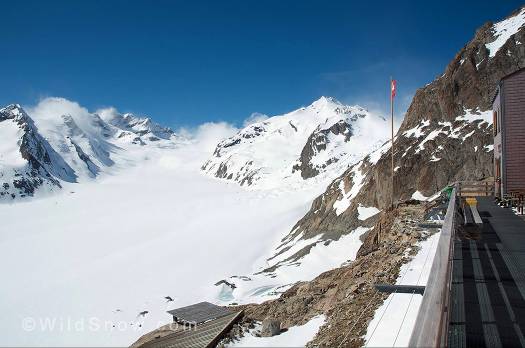Robert Suminsby
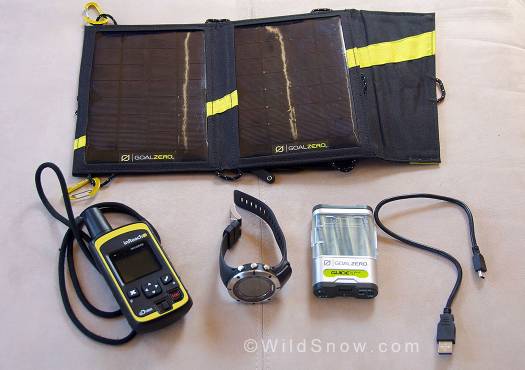
The Nomad 7 with (L to R) the InReach satellite communicator, Suunto Ambit 2 watch, and Guide 10 battery pack.
Technology comes at a cost. Beyond coin, the price you pay is in battery life.
I recently acquired a Suunto Ambit2 GPS watch, and have found it a godsend for a gadget geek backcountry traveler like myself. Although it lacks the background maps of a handheld GPS unit, it captures essential data like elapsed time, total ascent, and distance traveled. Most importantly, it captures an accurate track which (after syncing to your computer) is conveniently archived on Suunto’s website, where you can view it overlayed on Google Maps or export it in either *.gpx or *.kml format to use in other programs such as Google Earth. The Suunto website allows easy creation of navigation waypoints, or the upload of complete routes provided by the community of users.
After a typical day of backcountry ski touring this past season I had usually run the watch down to about half of a full charge. The very most I could hope to get out of it on an extended trip was two days, after which it would be just dead weight on my wrist.
Enter the Goal Zero Nomad 7 solar panel. I was planning a week long ski tour in the Bernese Oberland of Switzerland, and the Goal Zero would allow me to keep all my devices charged, including my iPhone 6 and my Delorme InReach satellite communicator. With a little luck, I would even have enough spare power to charge the GoPro Hero4 that my ski buddy and travel companion Ryan was bringing. And since the airlines are now trying to give me a guilt trip by printing on the itinerary just how much carbon would be burned to get me from New Mexico to Geneva, at least I could purchase a tiny bit of environmental salvation by going solar.
While you can buy the Goal Zero Nomad 7 panel as a stand-alone device, the company also offers it in a package deal bundled with the Guide 10 battery pack. The Guide 10 holds 4 included AA rechargeable batteries, and includes an adapter for AAA batteries. It offers inputs for charging from either a solar panel or a USB power source. The output is via a USB port. A multicolor LED provides a rough estimate of the Guide 10’s charge level, and a white LED serves as a flashlight. Who can’t use a backup flashlight?
The Guide 10 serves two important purposes. First, it gives you the flexibility to collect electrons by day, and redistribute them to your devices after sundown. Secondly, it provides for more convenient charging of devices like the iPhone, which seizes upon any interruption in power flow from a solar panel (such as a passing cloud) as an excuse to halt the charging process. The Guide 10 offers a steady flow of current and avoids some (but not all) of these issues. When the AA batteries in the Guide 10 are fully charged, they would charge my iPhone 6 at a rate of roughly 1% per minute initially, and from 30% to 100% in about 90 minutes. According to Goal Zero, the Nomad 7 panel will fully recharge the Guide 10 in 3-6 hours. Your mileage may vary, depending on the intensity of the sun and the orientation of the panel. If you’re just puttering around a campsite or a hut, you can shift the panel every so often to keep it perpendicular to the sun’s rays to get the most bang for your solar buck. On a ski tour, you’ll just have to attach it to your pack and hope for the best.
The Nomad 7 is a model of well thought out design. The two panels fold neatly into a package 6.25” x 9”, and a zippered pouch on the back provides convenient storage for the Guide 10 and associated cables. Six cord loops on the periphery and two included mini carabiners allow the Goal Zero to be attached to a pack, hung from a railing or rope line, or otherwise manipulated to keep it oriented towards the sun. The panel has 3 output cords: a proprietary mini-plug that connects to the Guide 10 (or another GZ battery pack), a female USB connection, and 12V connector. A blue LED indicates when the panel is producing power.
Of course, all the devices for my trip used different connections, so I had to bring along 4 different cables. A truly dedicated weight weenie would have shaved a few grams by buying a mini-USB to micro-USB adapter, but I decided to just man up and carry the extra couple inches of wire. The total weight of the Nomad 7, Guide 10 and 4 charging cables came to 1lb 10oz. No worries…I had purchased some lightweight crampons for this trip, so I was still within my mass budget.
I prepped for the trip by visiting the Suunto website and loading my Ambit2 with coordinates for all the huts we would visit as well as a few standard routes in the area. (The most interesting one available was “Junfraujoch to Wengen Wingsuit Flight”, but I figured I wasn’t really going to need that one.)
Some 18 hours after leaving sunny New Mexico, Ryan and I disembarked in Geneva under low overcast skies…an instant reminder of one of the fundamental limitations of solar power. When I had skied the Haute Route three years earlier, it had been under relentlessly clear blue skies. For the first time, it dawned on me that such favorable weather wasn’t guaranteed.
After schlepping our gear through the terminal, we boarded a train for Grindelwald. We spread out on the upper deck seating to enjoy the view, and I hauled out the InReach communicator to fire off a text letting my wife know we’d arrived safely. Of course, I could have paid the exorbitant international roaming rates and simply used my phone, but where’s the adventure in that? Furthermore, the InReach would allow friends back in the states to track my progress (via a weblink I had emailed to friends and family), and provide a rudimentary means of communication from high up in the mountains, beyond the reach of cell towers. Alas, getting a satellite signal from inside the train proved elusive, and I eventually gave up, not wanting to drain precious charge.
A few stops later, what seemed like half the Swiss Army boarded our train, apparently stealing away for weekend leaves. (Note to self: if planning to invade Switzerland, Saturday at 9am appears to be an opportune time.) As soon as they were seated, half the soldiers pulled out smart phones and charging cables, and plugged them into handy outlets above the seats. Outlets? On a train? Who knew? Not for the first time, I was reminded that the Swiss reputation for efficiency is well earned. Sadly, while I was well equipped with various cables and adapters, I had not brought one for the “different from the EU just because we can” 3-prong Swiss AC plug.
One of the pluses of a late season ski tour is that you get to begin and end amidst lush green surroundings. We had arrived in Grindelwald a day early to afford ourselves the chance to get a jump on jetlag. Ryan and I set off for an afternoon hike on one of the many “Wanderwegs” in the hills above town. That evening we met up with Kate, the only other American in our group, and she eagerly agreed to join us for an even longer hike the following day.
The following evening we joined the rest of our group, six Brits, for a get-acquainted dinner. Halfway through the meal our guides, Stefano and Gilles, arrived and joined us. Ryan and I had skied the Haute Route with Stefano in 2012, and were excited about the opportunity to tour with this easy-going Italian again. The group seemed to hit it off well, and we were excited to get into the mountains with this high-spirited crew.
Most excursions to the Bernese Oberland begin with a train ride to the Jungfraujoch, which rather cheekily bills itself as the “Top of Europe,” although at 3466m (11,332’) it is well below any number of cable car stations. That bit of marketing excess did not seem to deter any of the Japanese tourists thronging onto the train. We were the only skiers on the platform that Monday morning, and we seemed to have instant celebrity status among those waving smartphones on selfie sticks. As the train strained uphill towards the Kleine Scheidegg station, we peered in vain for a glimpse of the Eiger’s famous north face. Alas, it was mostly shrouded in cloud. After changing trains and then making the two obligatory 5-minute stops to peer out the gallery windows from inside the Eiger, we were on our way to the Jungfraujoch.
If you have never seen the Jungfraujoch, you may not fully appreciate the European penchant for building unlikely structures on mountaintops. Suffice it to say that if you are an egomaniacal madman setting up a shadowy organization bent on world domination, this is a piece of real estate you definitely want to acquire. When the hordes disgorged from the train at the summit station, we collected our skis and packs and wended our way through tunnels until we arrived abruptly at a dead end with a large steel door. Stefano pried open the door, letting in a blast of cold air and swirling snow. The lush green surroundings of Grindelwald suddenly felt very far away, and I decided that the Goal Zero could probably stay in my pack for this first leg of the journey.
Outside the visibility was less than 100 meters, and I felt a little sorry for all the tourists who’d paid over a hundred Swiss francs for a train to take them to the inside of a cloud. After quick gear checks, I clicked into my skis, set my Suunto Ambit2 to “Ski Touring” mode, selected the destination waypoint, and set off across the upper end of the Aletsch Glacier to the Mönchsjoch Hut. Knowing how far you have to go doesn’t get you there any faster, but it’s a nice psychological boost in a whiteout. Two thumbs up for the Suunto.
The Mönchsjoch Hut clings precariously to the southeast ridge of the Mönch at 12,000’, and sadly it does not offer a nice broad patio from which to enjoy the views, which were nonexistent upon arrival anyway. After settling in, I tried positioning the InReach in various windows hoping for a clear line of sight to a satellite, but eventually gave up, faced up to the wind and cold and ventured out onto a small catwalk, where I hitched it to a railing next to the toilets. It blinked happily as it sent my wife the news of our safe arrival at the hut.
The next morning, Tuesday, the weather was little better, but we geared up for our 3200’ descent of the Jungfraufirn. By about 10am, we had descended enough for the clouds to thin a bit, allowing glimpses of the glaciers overhanging on both sides. By the time we reached the magnificent Konkordiaplatz, where several glacial valleys converge, blue sky was beginning to peek through and spirits rose accordingly.
We cached excess gear under a rock and began to skin east up to the Grünhornlücke (3,280m/10,761’), which conveniently put the sun at my back, so I hauled out the Goal Zero panel and secured it to my pack, topping off the charge in the Guide 10 as I climbed towards the high pass that separates the Aletsch from its neighbor, the Fiescher Glacier. Nearing the summit of the pass, we were treated to grand views of the Finsteraarhorn, the highest peak in the Oberland region.
Our effort was rewarded by a nice descent through fresh snow. Retrieving our gear from the cache, we made our way to the foot of the steel steps crisscrossing a near vertical rock face, leading to the Konkordia Hut, surely one of the most spectacular settings in the Alps.
Four hundred and seventy-nine steps and a short scramble later, we were ensconced on the sunny deck of the Konkordia Hut, as pleasant a spot as any skier could ask for. It was fully stocked with the usual amenities, plus a friendly Labrador Retriever who lounged by the stove. The spacious deck overlooked a vast expanse of glacial terrain, and faced west into the glorious afternoon sunshine, which practically begged you to get a liter of beer and settle in for some relaxation.
Once the gear was stored, I geeked out to the data on my Suunto (12 miles, 3274’ of ascent, 6381’ of descent, etc.) before recharging it, then set out the InReach for a clear view of the sky and hung the Goal Zero where it faced the blazing afternoon sun. I fired off another note to friends and family to let them know all was well. The InReach also permits updates to social media, so naturally I did a bit of cyber-gloating to let my Facebook Friends know that I was soaking up sunshine in the Swiss Alps. Thus far, the Goal Zero was proving a winner.
Shop for Goal Zero here.
(WildSnow.com guest blogger Rob Suminsby is a retired U.S. Air Force officer who has been skiing for many decades. When Rob had to give up flying F-15s, he turned to off-piste skiing, and eventually ski touring, to get his thrills. He spent four years living in Germany and traveled over much of the Alps in search of untracked snow. He now resides in New Mexico and pillages powder in the Sangre de Cristo and San Juan mountains.)
Beyond our regular guest bloggers who have their own profiles, some of our one-timers end up being categorized under this generic profile. Once they do a few posts, we build a category. In any case, we sure appreciate ALL the WildSnow guest bloggers!

